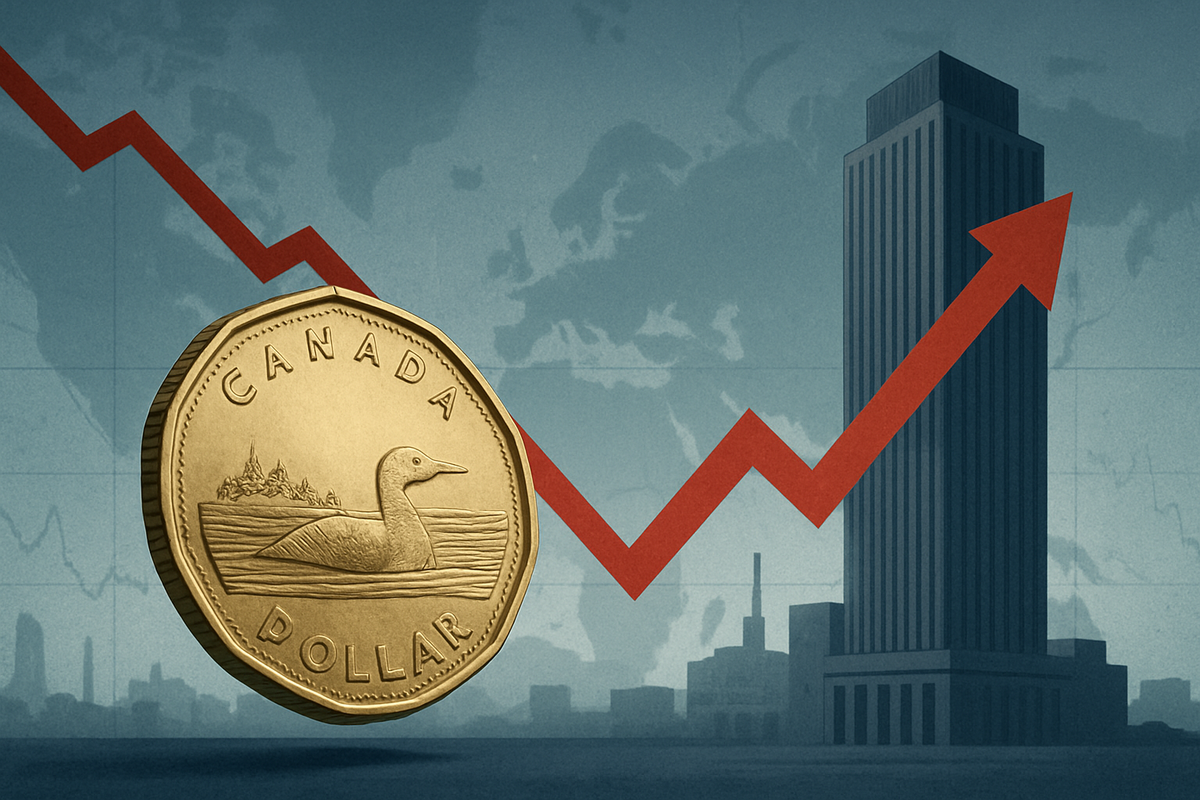
Toronto, ON – October 31, 2025 – The Canadian Dollar (CAD), affectionately known as the "loonie," has recently experienced a significant weakening against major global currencies, particularly the U.S. Dollar. This faltering is largely attributed to a confluence of factors: a discernible slowdown in Canada's domestic economic growth and a persistently hawkish stance from the United States Federal Reserve. The immediate implications are a heightened sense of volatility across international currency markets and a re-evaluation of economic forecasts for both Canada and its key trading partners.
The depreciation of the CAD signals a challenging period for Canadian businesses and consumers, as import costs rise and the purchasing power of Canadian earnings abroad diminishes. For global investors, the diverging monetary policies between the Bank of Canada and the Federal Reserve are creating a complex landscape, driving capital flows and reshaping risk assessments in an already uncertain global economic environment.
The Perfect Storm: A Detailed Look at the CAD's Decline
The Canadian Dollar's journey to its current weakened state has been a gradual yet impactful one, culminating in a notable depreciation by the close of October 2025. The USD/CAD exchange rate reached 1.4012, reflecting a stronger U.S. Dollar. Over the past month, the CAD depreciated by 0.56%, and its year-long performance saw a 0.45% decline against the greenback. Throughout October 2025, the CAD to USD exchange rate consistently hovered between approximately 0.713 and 0.717 USD per CAD.
The timeline of events leading to this moment highlights a clear policy divergence. The Bank of Canada (BoC) cut its overnight interest rate for the second consecutive time on October 29, 2025, bringing it to 2.25%. This move, part of an easing cycle that has seen 100 basis points in cuts since January 2025, was a direct response to evident economic weakness. The BoC revised its 2025 growth forecast downwards to 1.2% from an earlier 1.8%, acknowledging that U.S. tariffs and trade uncertainty are projected to reduce Canada's GDP by approximately 1.5% below initial expectations by the end of 2026.
Conversely, the U.S. Federal Reserve, while also having cut its benchmark interest rate twice in 2025 (in September and October) to a target range of 3.75% to 4.00%, maintained a surprisingly hawkish tone. Fed Chair Jerome Powell's statement after the October 29 meeting, indicating that a further rate cut in December was "far from a foregone conclusion," caught markets off guard. This statement bolstered the U.S. Dollar and pushed U.S. Treasury yields higher, creating a significant interest rate differential that favored the USD over the CAD. Key economic data underscoring Canada's slowdown includes a 0.3% month-over-month contraction in real Gross Domestic Product (GDP) in August 2025, coupled with a six-quarter decline in per capita GDP by Q3 2024. The Canadian labor market also showed weakness, with net job losses in August 2025 and an unemployment rate of 7.1%.
Winners and Losers: Corporate Impacts of a Weaker Loonie
The faltering Canadian Dollar creates a distinct set of winners and losers among public companies, primarily impacting those with significant international trade exposure.
Potential Winners:
- Canadian Exporters: Companies that primarily export goods and services priced in foreign currencies, especially USD, stand to benefit. A weaker CAD means their foreign currency revenues translate into more Canadian Dollars, boosting profitability. Examples could include large natural resource companies like Suncor Energy Inc. (TSX: SU, NYSE: SU) or Canadian Natural Resources Limited (TSX: CNQ, NYSE: CNQ), whose oil and gas products are priced in USD. Manufacturers exporting to the U.S. market, such as Magna International Inc. (TSX: MG, NYSE: MGA), could also see improved competitiveness and higher CAD-denominated earnings.
- Canadian Tourism Sector: A cheaper CAD makes Canada a more attractive and affordable destination for international tourists, potentially increasing visitor numbers and revenue for airlines like Air Canada (TSX: AC) and hospitality groups.
Potential Losers:
- Canadian Importers: Businesses that rely heavily on imported goods, raw materials, or components will face higher costs. Retailers like Loblaw Companies Limited (TSX: L) or electronics distributors importing from the U.S. or Asia will see their procurement expenses rise, potentially squeezing profit margins or leading to higher consumer prices.
- Canadian Consumers: The average Canadian consumer will feel the pinch through higher prices for imported goods, including electronics, fresh produce out of season, and U.S.-made products. Traveling abroad also becomes more expensive.
- Companies with USD-denominated Debt: Canadian companies that have borrowed heavily in U.S. Dollars but generate revenues primarily in CAD will find their debt servicing costs increase, placing additional financial strain.
- U.S. Exporters to Canada: While a weaker CAD makes Canadian goods cheaper for U.S. buyers, it makes U.S. goods more expensive for Canadian buyers. U.S. companies like General Motors Company (NYSE: GM) or Apple Inc. (NASDAQ: AAPL), which have significant sales in the Canadian market, might see reduced demand or lower CAD-denominated revenues translate into fewer USD.
Wider Significance: Global Ripples and Historical Context
The Canadian Dollar's recent struggles are not an isolated incident but rather a significant indicator of broader trends in global currency markets, particularly the outsized influence of the U.S. Federal Reserve's monetary policy. This event underscores a prevailing theme: in an interconnected global economy, policy decisions by major central banks, especially the Fed, can create substantial ripple effects far beyond their domestic borders.
The divergence in monetary policy, with the Bank of Canada easing aggressively to combat a domestic slowdown and the Fed maintaining a comparatively hawkish stance despite its own rate cuts, highlights a "flight to safety" dynamic. When global economic uncertainty rises, and a major central bank like the Fed signals less aggressive future easing, the U.S. Dollar tends to strengthen as investors seek the perceived stability and higher yields of U.S. assets. This dynamic can put pressure on other currencies, particularly those of commodity-exporting nations like Canada.
Historically, the CAD has often been sensitive to commodity prices, especially oil. While West Texas Intermediate (WTI) crude saw a nearly 2% drop in the week leading up to October 31, 2025, contributing to the CAD's weakness, the current situation also draws parallels to periods where significant interest rate differentials between the U.S. and Canada led to prolonged periods of CAD depreciation. Regulatory bodies in both countries will be closely monitoring these currency movements for potential impacts on trade balances, capital flows, and financial stability. The event could also spur discussions on the need for greater international policy coordination to mitigate excessive currency volatility.
What Comes Next: Navigating the Uncertain Waters
Looking ahead, the trajectory of the Canadian Dollar will largely depend on the evolving economic narratives in both Canada and the United States, as well as the future policy decisions of their respective central banks.
In the short term, the CAD is likely to remain volatile. Any further signs of Canadian economic weakness, or stronger-than-expected U.S. economic data, could exert additional downward pressure. Conversely, an unexpected softening in the Fed's hawkish tone or a significant rebound in commodity prices could provide some relief for the loonie. Businesses with international exposure will need to consider hedging strategies to mitigate currency risk, while those operating solely within Canada might face inflationary pressures from rising import costs.
In the long term, Canada's economic resilience and its ability to diversify away from a heavy reliance on natural resources will be crucial. The Bank of Canada's characterization of the current weakness as a "structural transition" suggests that a quick rebound may be challenging. Strategic pivots for Canadian industries might include focusing on domestic supply chains or seeking new export markets beyond the U.S. if trade tensions persist. For investors, opportunities may emerge in Canadian companies that are net exporters or those with strong domestic demand that are less susceptible to currency fluctuations. The key challenges will involve managing inflationary pressures and adapting to a potentially prolonged period of higher import costs.
Comprehensive Wrap-up: A New Economic Reality
The recent faltering of the Canadian Dollar serves as a powerful reminder of the intricate linkages within the global financial system. The combination of Canada's slowing economic growth and the Federal Reserve's hawkish stance has created a formidable headwind for the loonie, reshaping currency markets and influencing economic forecasts.
The key takeaways are clear: Canada's economy is undergoing a significant adjustment period, exacerbated by trade uncertainties and a less favorable interest rate differential with its largest trading partner. For the market moving forward, expect continued volatility in the USD/CAD pair, with the U.S. Dollar likely maintaining its strength as long as the Fed's stance remains comparatively hawkish. Investors should closely watch for further economic data releases from both countries, particularly inflation figures, employment reports, and any shifts in central bank rhetoric. Geopolitical developments and commodity price movements, especially oil, will also remain critical determinants of the CAD's future performance. The current environment necessitates a cautious yet adaptable approach, as the lasting impact of these events could redefine Canada's economic landscape for years to come.
This content is intended for informational purposes only and is not financial advice







